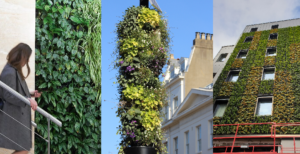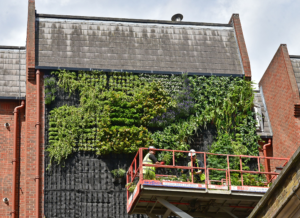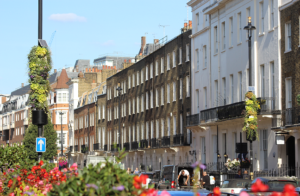
The Professional Voices blog allows people within the industry to share their thoughts on a particular topic. Today, we hear from Anna Roochove, from Scotscape, who has some views on supporting species by using smart horticultural systems in urban environs.
J: In the ecology world we are hearing a lot about Government plans to help reduce the impact of climate change on the environment. Interestingly, they are currently reviewing the Environment Bill, which can be found on the Parliament website. So, Anna what do you feel is the priority for Scotscape?
A : This is a busy and exciting time for the horticultural industry. The collective consciousness surrounding the need to mitigate climate change, reduce air pollution, boost biodiversity to support pollinators and create towns and cities which support mental health and wellness dominates what we do here at Scotscape. Government and the media are starting to play a big part in driving the green agenda which supports our goals.
: This is a busy and exciting time for the horticultural industry. The collective consciousness surrounding the need to mitigate climate change, reduce air pollution, boost biodiversity to support pollinators and create towns and cities which support mental health and wellness dominates what we do here at Scotscape. Government and the media are starting to play a big part in driving the green agenda which supports our goals.
J: Research shows that introducing biophilia and plant life into the urban environment are important for cooling inner city temperatures and mitigating the urban heat island, as well as improving air quality and acting as resource for a variety of bird and insect species. Indeed, the use of vertical greening systems are an increasingly important element of urban design. In order to support species that move around the environment it is important to ensure that any systems are packed with healthy plant species. What is your experience in achieving this?
A. Our experience with living walls began back in 2008 just as they were becoming known in the UK. Having worked with most systems on the market and maintained them we made a move to use only Fytotextile 7 years ago. The patented Fytotextile system is excellent, we have found that nothing supports plant health as well. The aerated structure of the fabric has been designed to bring oxygen to the root system of plants, meaning bigger and more robust growth. It is also lightweight, at only 35kg per square meter fully planted and irrigated and it has a flexible structure meaning it can be applied to a myriad of surfaces. It can also be made with varying pocket sizes to accommodate larger species and more biodiversity. The living pillar innovation utilises Fytotextile as the planting structure, meaning that we are experiencing the same vigorous plant health in this product too.
J: Further to this, how do your products influence the urban environment?
 A. In tests carried out at the University of Sheffield by Scotscape, the measurement of brick temperature on a hot summers day was over 40°C, a reading taken on the same day at the same time where a living wall had been installed showed a dramatic reduction of temperature down to 20°C. This will keep the air-temperature around the building cooler through evapo-transpiration and shade, and also reduce energy consumption, as the need to provide ambient temperatures is partly achieved through the cooling action of the wall.
A. In tests carried out at the University of Sheffield by Scotscape, the measurement of brick temperature on a hot summers day was over 40°C, a reading taken on the same day at the same time where a living wall had been installed showed a dramatic reduction of temperature down to 20°C. This will keep the air-temperature around the building cooler through evapo-transpiration and shade, and also reduce energy consumption, as the need to provide ambient temperatures is partly achieved through the cooling action of the wall.
In terms of biodiversity, our built environment has stripped out nature – leaving animals little or no resources to forage and exist. Creating living walls which are planted for function is crucial – sourcing native plants which support pollinators and birds is a good solution. Our ‘pollinator wall’ which we created with the Charity Bug Life, is planted specifically to attract a broad range of insects and birds and has successfully done so. During our many living wall maintenance rounds we discover nesting birds, butterflies and bees happily existing, however what is crucial especially for our pollinators is to create channels of foraging sites. In the built environment this can be achieved with functional planting in living walls, green roofs and in traditional landscapes.
J: How is smart horticulture applied by Scotscape?
 A. Working with ecologists as we design living walls and living pillars ensures that horticultural species selection not only functions well in terms of site and aspect but also is optimised to deliver the best benefits for habitat creation and pollinating insects. In terms of our interior landscaping projects which include living walls and more traditional planted combinations we work on latest guidance from researchers and universities to ensure that we are specifying installations which bring genuine benefits to building users, this includes both correct plant selection and volume of plants to have an impact. As a business we have engaged in several research projects with Universities to quantify the benefits of urban greening, these include University of Sheffield, University of Greenwich and University of Cambridge.
A. Working with ecologists as we design living walls and living pillars ensures that horticultural species selection not only functions well in terms of site and aspect but also is optimised to deliver the best benefits for habitat creation and pollinating insects. In terms of our interior landscaping projects which include living walls and more traditional planted combinations we work on latest guidance from researchers and universities to ensure that we are specifying installations which bring genuine benefits to building users, this includes both correct plant selection and volume of plants to have an impact. As a business we have engaged in several research projects with Universities to quantify the benefits of urban greening, these include University of Sheffield, University of Greenwich and University of Cambridge.
J: Thanks Anna.
This is an interesting topic with plenty of research out there, including a paper by Opuku (2018) who highlights how the built environment has been a major contributor to biodiversity loss, and how these areas should play a substantial role in ecological enhancement. Opuku acknowledges that the urban environment provides opportunities to integrate biodiversity into all building projects. This will not only improve things from an ecological perspective, but also improve the well-being of residents. A study by
A little bit about the authors

Anna Roochove is a Marketing Manager at Scotscape.
Anna is a marketing manager for the Scotscape Group of companies. She is an enthusiastic team member who enjoys the variety of her work. She is inspired by spreading the message about the benefits of greening cities, and states that it is hugely satisfying to work with a proactive and innovative team with goals collectively set on changing how our urban areas look and feel.
Scotscape offers the complete green solution. As multi-disciplinary landscapers and nurturing horticulturalists they offer all landscaping services for commercial and domestic projects, living walls, living pillars, living wall maintenance and landscape maintenance. Scotscape also develop bespoke greening solutions to meet the growing demand for intelligent urban greening, creating green streets and parklets to support more sustainable cities. Scotscape are a group of professionals who are keen to leave a green legacy, and they are proud to be part of the movement to green up the built environment.
Follow Scotscape on Facebook, Twitter, Instagram, and LinkedIn

Dr Julia Lock is a New Product Specialist at Wildcare.
Wildcare are committed to supporting the ecology industry with the best products and service. Wildcare regard themselves as a little unique. Wildcare knows what it is like to be out in the field, wet, cold and struggling to finish a job that would have been finished in the sunshine yesterday, if only the supplies had turned up on time. We understand how clients don't give you the go-ahead until the season is already upon you and you simply have to get your equipment the next day. We are here to get you the products you need, at the prices you expect to pay, to the place you need them, when you need them.
Follow Wildcare on Facebook, Twitter and LinkedIn
Edited by Carmen Wheatcroft


